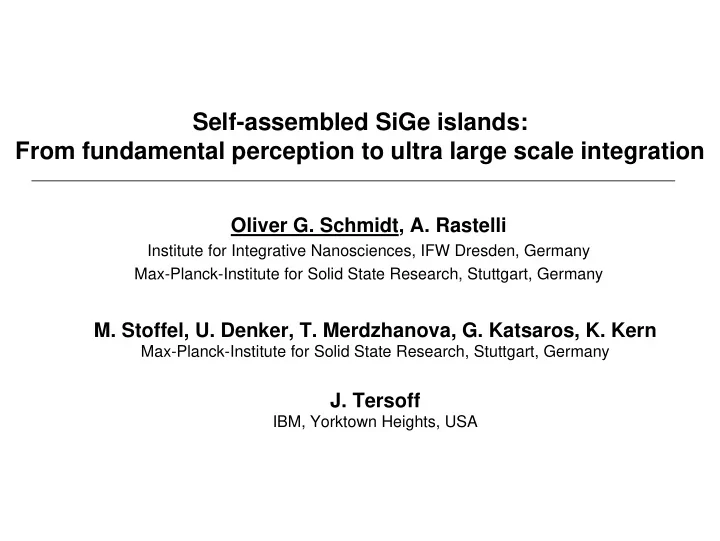

Self-assembled SiGe islands: From fundamental perception to ultra large scale integration Oliver G. Schmidt, A. Rastelli Institute for Integrative Nanosciences, IFW Dresden, Germany Max-Planck-Institute for Solid State Research, Stuttgart, Germany M. Stoffel, U. Denker, T. Merdzhanova, G. Katsaros, K. Kern Max-Planck-Institute for Solid State Research, Stuttgart, Germany J. Tersoff IBM, Yorktown Heights, USA
500 ° C, 3 ML Ge
475 ° C, > 3 ML Ge
Probing the lateral composition profile of SiGe islands Before etching After selective etching Simulation (2 min in 31% H 2 O 2 ) Grown at 560 ° C Top view 6 ML Ge at 560 °C, 500 s GI U. Denker, M. Stoffel, and O. G. Schmidt, Phys. Rev. Lett. 90, 196102 (2003).
Trench formation around SiGe islands X. Z. Liao et al., Phys. Rev. B 60, 15605 (1999)
APL 78, 3723 (2001) U. Denker et al., 2 x 2 μ m 2
Trenches after post-growth annealing (in-situ) 10 ML Ge at 740 ° C After 2 min. etching in HF/H 2 O 2 /CH 3 COOH (BPA solution) + 10 min. anneal 740 ° C + 1 min. anneal 740 ° C 2.9 μ m x 2.9 μ m <110> - Before annealing: Si plateau at the center of the trench - After annealing: only a part of the initial Si plateau remains and and a wide shallow trench appears Island motion
Lateral SiGe island motion during in-situ annealing U. Denker, A. Rastelli, M. Stoffel, J. Tersoff, G. Katsaros, G. Costantini, K. Kern, D. E. Jesson, and O. G. Schmidt, Phys. Rev. Lett. 94, 216103 (2005). Evidence of asymmetric alloying Wet chemical etching in a NH 4 OH/H 2 O 2 solution (Etches Ge-rich SiGe alloys) No etch 80 min. (440 nm) 2 170 min. Full etch - Ge rich part at the left side of the island - Si rich part at the right side of the island Island motion: efficient Si-Ge intermixing by surface diffusion
Lateral SiGe island motion during in-situ annealing Mean island displacement 8 200 7 Displacement <d> (nm) 6 Volume (x 10 6 nm 3 ) 150 5 4 100 3 50 2 1 0 0 0 40 80 120 160 Annealing time (min.) - Short annealing times: rapid island motion - Island motion slows down for annealing times > 20 min. Once the island has intermixed, lateral motion ceases
Probing the lateral composition profile of SiGe islands Before etching After selective etching (2 min in 31% H 2 O 2 ) Grown at 560 ° C Top view 6 ML Ge at 560 °C, 500 s GI U. Denker, M. Stoffel, and O. G. Schmidt, Phys. Rev. Lett. 90, 196102 (2003).
Trench formation around SiGe islands X. Z. Liao et al., Phys. Rev. B 60, 15605 (1999)
Dendrochronology (Study of tree-rings of dislocated superdomes) Douglas-fir SiGe islands (photo H.D. Grissino-Mayer) T. Merdzhanova, S. Kiravittaya, M. Stoffel, A. Rastelli, and O. G. Schmidt Phys. Rev. Lett. 96, 226103 (2006)
Revealing the details of capped SiGe islands 2x2 μ m 2 5.9 ML Ge, 580 °C 20 nm Si „Ziggurat“ After Si cap etching Composition profile Although islands look completely different after capping, they remain practically unchanged below the Si !!! G. Katsaros et al., APL 89, 253105 (2006)
However, low Ge concentration used (only 17 %)
„…as the spacing between transistors is reduced with scaling, techniques such as embedded SiGe or Si:C in the source/drain …becomes less effective at inducing stress in the channel.“ (ITRS 2007 edition) ITRS: I nternational T echnology R oadmap for S emiconductors
Modeling the realistic barn- -shaped island shaped island Modeling the realistic barn ε xx Ge concentration = 60 % concentration = 60 % x = [100] Ge x = [100] Interuniversity Center Milano Bicocca - Politecnico di Milano Nanometric Epitaxial Structures on silicon and Spintronics
Strain induced in capping layer Strain induced in capping layer ε xx 30 nm 30 nm Island 125 nm 125 nm x = [100] x = [100] Interuniversity Center Milano Bicocca - Politecnico di Milano Nanometric Epitaxial Structures on silicon and Spintronics
Field Effect Transistor based on embedded SiGe island structures (DotFET) O. G. Schmidt and K. Eberl, US 6,498,359 (2000) IEEE Trans. Electron. Devices 48, 1175 (2001) MOSFET: The key device for ULSI technology.
„Reverse embedded SiGe“ Si 25% Ge R. A. Donaton et al. (IBM), IEDM Tech. Dig. ,2006, pp. 465. A buried SiGe island is very effective at inducing uniaxial tensile strain in the nFET channel for a 15% improvement in drive current and 40% mobility enhancement. The TEM shows the device following silicon regrowth in the source/drain. (Source: IBM)
„SiGe strain transfer structure“ Single stressor Dual stressor (Added Carbon) 18% improvement in drive current 40% improvement in drive current 40% improvement of mobility 78% improvement of mobility K.W. Ang et al., IEEE Electron Device Lett. 28, 609 (2007) K.W. Ang et al., IEEE Trans. Electr. Devices 55, 850 (2008)
Perfect ordering of SiGe islands Funded by: EU project D-DotFET
Ge dot positioning on CMOS compatible wafers Zoom-in (3D-view) Overview (Top-view) G. S. Kar, S. Kiravittaya, U. Denker, B.Y. Nguyen, and O. G. Schmidt, Appl. Phys. Lett. 88, 253108 (2006)
ITRS 2007 Source:
„A method of making a semiconductor device having an arched structure strained semiconductor layer“ B.-Y. Nguyen, S. G. Thomas, A. Wild, P. Wennekers, L. Cergel, T. White, A. Thean, M. Sadaka Freescale Semiconductor Inc. D. Grützmacher Paul-Scherrer-Institut, CH5232, Switzerland O. G. Schmidt Max-Planck-Institut für Festkörperforschung, Heisenbergstr. 1, D-70569 Stuttgart US Patentanmeldungen: 11/093,645 11/094,008
Conclusion - Further transistor scaling requires rigorous increase of strain in channel - SiGe island growth is well-understood and could help to establish sufficient strain down to 22nm technology
Recommend
More recommend